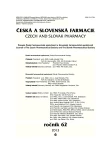Influence of quaternary ammonium salt on liberation of drug with antiseptic effect
Authors:
Zuzana Vitková; Petra Herdová; Jarmila Oremusová; Jozef Čižmárik; Katarína Tóthová
Authors place of work:
Bratislava
; Katedra galenickej farmácie Farmaceutická fakulta UK
Published in the journal:
Čes. slov. Farm., 2013; 62, 255-258
Category:
Původní práce
Summary
The paper evaluates the influence of three surfactants (carbetopendecinium halogenides) on the liberation of the drug chlorhexidine dihydrochloride (CHX) in 0.1% (w/w) from the dosage form-gel and also the flow properties of gels. The following tensides were evaluated: carbetopendecinium bromide (SB), carbetopendecinium chloride (SC), and carbetopendecinium iodide (SI). The tenside concentration was set under the critical micelle concentration. The biopolymer – chitosan (CHIT) in 2.5% (w/w) concentration was used as a gel creating substance. Based on the flow properties of the studied gels, it was found that the employed tensides exhibited no influence on the character of the system. The gels exhibited the character of plastic systems with time-independent flow. The drug liberation was evaluated at the temperatures of 20, 30 and 40 °C. Between the types of the tensides, the statistically significant differences (P < 0.05) were found as to the amount of the liberated CHX, which was reflected by the increased amount of the liberated drug. Based on the obtained results, it can be concluded that the most suitable was the SI tenside. From the gel with this tenside the greatest amount of CHX was liberated, which had the highest value of the liberation rate constant.
Keywords:
chlorhexidine dihydrochloride, tensides, chitosan, liberation
Zdroje
1. Broze G. Handbook of Detergents Part A: Properties. In: Surfactant Science Series. New York: Marcel Dekker 1999; 82, 8 a 23–24.
2. Waldhoff H., Spilker R. Handbook of Detergents Part C: Analysis. In: Surfactant Science Series. New York: Marcel Dekker 2005; 123, 291.
3. http://www.adcc.sk/web/humanne-lieky/spc/septonex-spc-23620.html (12. 9. 2013)
4. Oremusová J., Vitková Z., Herdová P. Influence of Adjuvances on the Drug Release from Hydrogels. Sci Pharm. 2010; 78(3), 627.
5. http://www.lekopis.cz/Kap_6_1_Carbethopendecinii_bromidum. htm (12. 9. 2013)
6. Lincová D., Farghali H. Základní a aplikovaná farmakologie. 2. vyd. Praha: Galén 2007; 592–594.
7. Oremusová J., Greksáková O. Micellzation Parameters of Cationic Surfactants Consisting of the [1-(Ethoxycarbonyl)-pentadecyl]/trimethylammonium Ion and Various Anions. Tenside Surf. Det. 2003; 40(1): 35–39.
Štítky
Farmacie FarmakologieČlánek vyšel v časopise
Česká a slovenská farmacie

2013 Číslo 6
- Přerušovaný půst může mít významná zdravotní rizika
- Ukažte mi, jak kašlete, a já vám řeknu, co vám je
- FDA varuje před selfmonitoringem cukru pomocí chytrých hodinek. Jak je to v Česku?
Nejčtenější v tomto čísle
- Pohľad na poskytovanie starostlivosti v oblasti liekov na Slovensku – lekárnik a pacient
- Alkalimetrické titrácie solí organických zásad v liekopise
- Vplyv kvartérnej amóniovej soli na liberáciu liečiva s antiseptickým účinkom
- Fyziologické faktory ovlivňující osud léčiva v gastrointestinálním traktu
